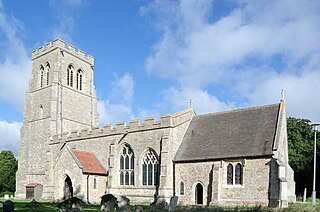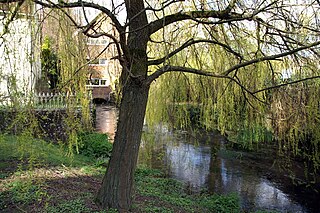
Marks Tey is a large village and electoral ward in Essex, England; it is located six miles west of Colchester.

Old Sodbury is a small village and former civil parish in the valley of the River Frome just below and to the west of the Cotswold escarpment and to the east of Chipping Sodbury and Yate, now in the parish of Sodbury, in the South Gloucestershire district, in the ceremonial county of Gloucestershire, England. It is situated in the Hundred of Grumbald's Ash. The village extends from Chipping Sodbury in the West to the Cotswold Edge in the East and is on the Cotswold Way. The Badminton Road (A432) winds eastwards towards Badminton, Gloucestershire through the village, up to the Cross Hands junction with the A46, which runs along the top of the Cotswold escarpment from Bath to Stroud. In 1931 the parish had a population of 837. On 1 April 1946 the parish was abolished to form Sodbury.

Bolnhurst is a small village and former civil parish, now in the parish of Bolnhurst and Keysoe, in the Borough of Bedford, Bedfordshire, England. The village is about 6 miles (9.7 km) north-northeast of Bedford town centre and about 6 miles (10 km) west of St Neots. In 1931 the parish had a population of 162.

Assington is a village in Suffolk, England, 4 miles (6.4 km) south-east of Sudbury. At the 2011 Census it had a population of 402, estimated at 445 in 2019. The parish includes the hamlets of Rose Green and Dorking Tye.

Corhampton is a village and former civil parish, now in the parish of Corhampton and Meonstoke, in the Winchester district, in the county of Hampshire, England. It lies on the western bank of the River Meon. In 1931 the parish had a population of 87. On 1 April 1932 the parish was abolished and merged with Meonstoke to form "Corhampton and Meonstoke".

Botolphs, formerly known as Annington, is a tiny village and former civil parish, now in the parish of Bramber, in the Horsham District of West Sussex, England. It is in the Adur Valley 1.5 miles (2.4 km) southeast of Steyning on the road between Steyning and Coombes. Botolphs lies on the South Downs Way long-distance footpath. In 1931 the parish had a population of 64. On 1 April 1933 the parish was abolished and merged with Bramber.

Chappel is a village and civil parish in the City of Colchester district of Essex, England. The River Colne flows through the village. It is significant for its Victorian viaduct, which crosses the Colne valley.

Berechurch is an area of Colchester and former civil parish, now in the unparished area of Colchester, in the Colchester district, in the county of Essex, England. In 1891 the parish had a population of 167. On 26 March 1897 the parish was abolished to form Colchester.

Avington is a village and former civil parish, now in the parish of Kintbury, in the West Berkshire district, in the ceremonial county of Berkshire, England. The village is on the River Kennet, just under 1 mile (1.6 km) northwest of Kintbury village and 2 miles (3 km) east of the town of Hungerford. The Kennet and Avon Canal follows the river and passes the village. In 1931 the parish had a population of 77. On 1 April 1934 the parish was abolished and merged with Kintbury.

Broughton Poggs is a village in the civil parish of Filkins and Broughton Poggs in West Oxfordshire. Broughton Poggs is 3 miles (5 km) southwest of Carterton.

North Marden is a tiny village and former civil parish, now in the parish of Marden, in the Chichester district of West Sussex, England. It is 7.5 miles (12 km) northwest of Chichesteron the spur of the South Downs and on the B2141 road. In 1931 the parish had a population of 12. On 1 April 1933 the parish was abolished to from "Marden".

Hardham is a small village and former civil parish, now in the parish of Coldwaltham, in the Horsham district of West Sussex, England. It is on the A29 road 1.2 miles (2 km) southwest of Pulborough. In 1931 the parish had a population of 107.

Copford is a village and civil parish in the City of Colchester district of Essex, England. It is 3 kilometres (2 mi) west of Colchester, and the hamlet of Copford Green is found a short distance to the south. The poet Matthew Arnold noted he was struck by "the deeply rural character of the village and neighbourhood."

Larling is a village and former civil parish, now in the parish of Roudham and Larling, in the Breckland district, in the county of Norfolk, England. The village is 8.5 miles east north east of Thetford, 21.4 miles west south west of Norwich and 94 miles north east of London. In 1931 the parish had a population of 159.

Great Tey is a village and civil parish in the City of Colchester district of Essex, England. It is near the villages of Marks Tey and Little Tey, located approximately six miles west of Colchester.

Easthorpe is a small village and former civil parish, now in the parish of Copford, in the Colchester district, in the county of Essex, England. Easthorpe is on an old Roman road. Nearby settlements include the large town of Colchester and the villages of Marks Tey, Copford and Copford Green. The main A12 road and Marks Tey railway station are nearby. In 1931 the parish had a population of 113. On 26 March 1949 the parish was abolished and merged with Copford, part also went to Marks Tey and Messing cum Inworth.

Great Wigborough is a village and former civil parish, now in the parish of Great and Little Wigborough in the Colchester borough of Essex, England.

Naughton is a village and former civil parish, now in the civil parish of Nedging-with-Naughton, in the Babergh district, in the county of Suffolk, England. It is 10 miles (16 km) north-west of Ipswich and 7 miles (11 km) south-west of Stowmarket. It was historically within the Cosford Hundred of Suffolk. The civil parish was merged with Nedging on 1 April 1935 to create "Nedging with Naughton". In 1931 the civil parish had a population of 98.

Great Henny is a village and civil parish near Sudbury, in the Braintree district, in the county of Essex, England. Nearby settlements include the villages of Little Henny and Twinstead. The hamlet of Henny Street, within the parish, is on the River Stour which forms the parish's eastern border.

Little Wigborough is a village and former civil parish, now in the parish of Great and Little Wigborough, in the Colchester borough of Essex, England and forms part of Winstred Hundred Parish Council. Little Wigborough is located between Peldon and Great Wigborough. In 1951 the parish had a population of 45.





















